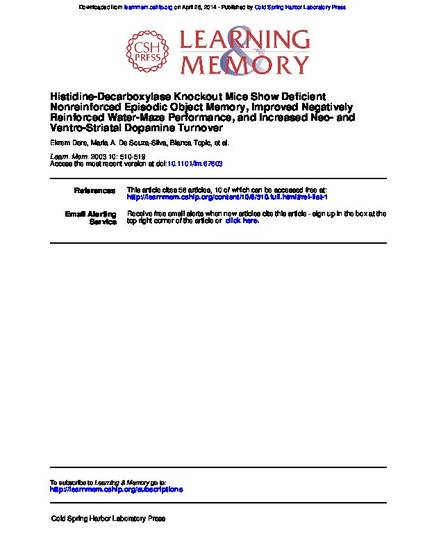
The brain's histaminergic system has been implicated in hippocampal synaptic plasticity, learning, and memory, as well as brain reward and reinforcement. Our past pharmacological and lesion studies indicated that the brain's histamine system exerts inhibitory effects on the brain's reinforcement respective reward system reciprocal to mesolimbic dopamine systems, thereby modulating learning and memory performance. Given the close functional relationship between brain reinforcement and memory processes, the total disruption of brain histamine synthesis via genetic disruption of its synthesizing enzyme, histidine decarboxylase (HDC), in the mouse might have differential effects on learning dependent on the task-inherent reinforcement contingencies. Here, we investigated the effects of an HDC gene disruption in the mouse in a nonreinforced object exploration task and a negatively reinforced water-maze task as well as on neo- and ventro-striatal dopamine systems known to be involved in brain reward and reinforcement. Histidine decarboxylase knockout (HDC-KO) mice had higher dihydrophenylacetic acid concentrations and a higher dihydrophenylacetic acid/dopamine ratio in the neostriatum. In the ventral striatum, dihydrophenylacetic acid/dopamine and 3-methoxytyramine/dopamine ratios were higher in HDC-KO mice. Furthermore, the HDC-KO mice showed improved water-maze performance during both hidden and cued platform tasks, but deficient object discrimination based on temporal relationships. Our data imply that disruption of brain histamine synthesis can have both memory promoting and suppressive effects via distinct and independent mechanisms and further indicate that these opposed effects are related to the task-inherent reinforcement contingencies.
Available at: http://works.bepress.com/richard-spieler/86/

©2003 by Cold Spring Harbor Labnoratory Press